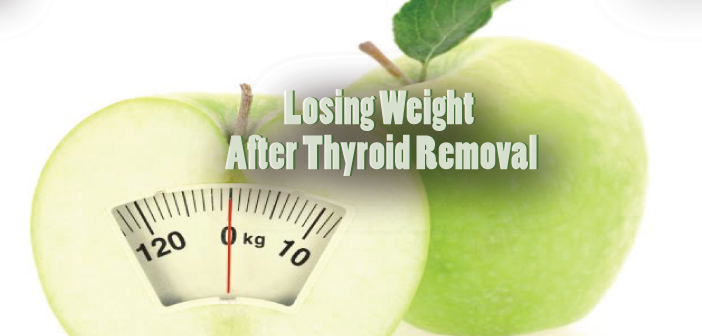
Kristeen Cherney,
Livestrong
Thyroid Nation
The thyroid gland produces hormones that balance all body functions, including your metabolism. Your metabolism converts food into energy, and is partly responsible for your weight. If the thyroid gland is removed through a procedure called a thyroidectomy, your metabolism is disrupted from the lack of thyroid hormones. As a result, you could gain weight after the procedure. The key to weight loss is keeping up with medical treatment and taking steps on your own to keep your weight in control.
Step 1
Take prescription thyroxine, or T4 hormone replacements such as Synthroid and Levothyroxine. You will have to replace these thyroid hormones through prescription drugs for the rest of your life. The Mayo Clinic explains that without hormone replacements, your body enters a state of hypothyroidism after a thyroidectomy. Hypothyroidism slows down the metabolism, causing weight gain.
Step 2
Consider triiodothyronine, or T3, hormone replacements. Triiodothyronine is one of the types of thyroid hormones, but it is not typically replaced with prescription hormones because it is not as prevalent. However, Thyroid-Info.com explains that a T3 supplement taken in conjunction with prescription hormone replacements can better balance your body and make up for the lack of thyroid, thereby increasing potential weight loss.
Step 3
Reduce the amount of complex carbohydrates in your diet. Examples of complex carbohydrates include potatoes, white bread, pasta, and rice. According to Thyroid-Info, hypothyroidism is linked to insulin resistance, making it more difficult for your body to metabolize such foods. Eating too many complex carbohydrates can make you gain weight easily after a thyroidectomy.
Step 4
Eat a diet that consists of lean meats, green leafy vegetables, low-sugar fruits, and low-fat dairy products. Foods with a high fat or sugar content will make it more difficult to lose weight, even if you are on hormone replacements.
Step 5
Exercise regularly. If you are new to exercising, try walking as often as you can. Then you can build up to high-intensity cardio activities such as running and kick-boxing, as well as strength-training routines. Losing fat and building muscle will further enhance your metabolism to make up for your lack of thyroid gland. (Remember to do exercise appropriate workouts for your fitness level)
About the Author
 Kristeen Cherney began writing healthy lifestyle and education articles in 2008. Since then, her work has appeared in various publications. Including Livestrong.com, Healthline.com, IdealHealth.com, and FindCollegeInfo.com. Kristeen holds a Bachelor of Arts in communication from Florida Gulf Coast University and is currently pursuing a Master of Arts in English.
Kristeen Cherney began writing healthy lifestyle and education articles in 2008. Since then, her work has appeared in various publications. Including Livestrong.com, Healthline.com, IdealHealth.com, and FindCollegeInfo.com. Kristeen holds a Bachelor of Arts in communication from Florida Gulf Coast University and is currently pursuing a Master of Arts in English.
While you’re at it, PLEASE ‘Like’ Thyroid Nation on Facebook and follow us on Twitter, Thyroid Nation RADIO, and Periscope.
Questions or anything to add about thyroid and losing weight? We’d love your thoughts in the comments section!





I do not believe that you are correct about the low carb AND low fat advice. The low carb advice holds good for everybody, including those who still have a thyroid. But the fats are a different matter. Healthy fats are good for the body and have been shown to help with other hormone levels. In addition, fats such as butter and coconut oil are good for the dry skin associated with hypothyroidism. Further, vitamin D which is so important for health, is synthesised from cholesterol.
We have been brainwashed for far too long to see fat as the enemy, when in fact fats are our friend, not the trashy manufactured polyunsaturated stuff like rapeseed and sunflower oil, but olive oil, grass fed butter, coconut oil, even lard and suet if you want to fry something, because they are more stable when heated. Most of our calories should be coming from fats rather than carbs or sugar, which does not mean a lot of fat because it is calorie dense.
Please stop telling people to eat low fat.